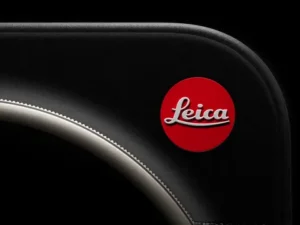On Sept 24, 2025, Xiaomi held a global launch event in Munich to unveil the new Xiaomi 15T series. The lineup includes two models – the Xiaomi 15T and the higher-end 15T Pro – both positioned as “sub-flagship” phones. The event highlighted a “Pro-grade” Leica camera experience (including Xiaomi’s first 5× optical telephoto lens on a T-series phone) and a fresh “golden” design theme with a matte metallic finish.
New software features were also announced, such as a lock-screen “Leica Street Photography” quick-shot mode and an offline walkie-talkie mode (using high-powered Bluetooth to let 15T phones call each other up to ~1.9 km apart without cell service). In this guide we’ll break down what was announced, compare the 15T vs. 15T Pro, and summarize first impressions from reviewers.
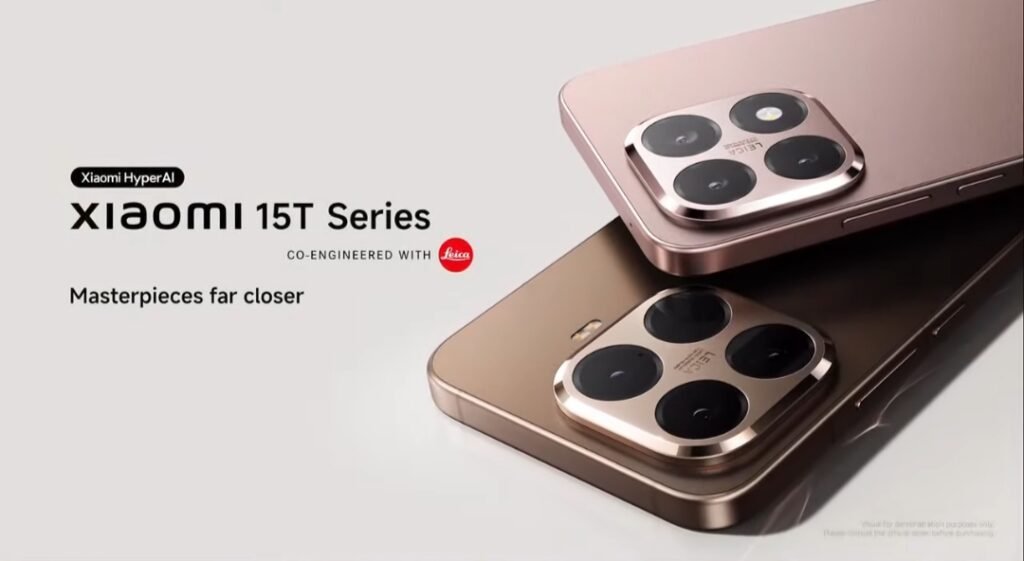
Design & Display
The Xiaomi 15T Series are identical in a brand new appearance: flat aluminum frames, razor-thin uniform bezels (1.5mm only), and a matte glass-fiber back that does not catch smudges. The phones are firm and high-quality. A larger heavier (162.7779.6mm, 210grams) 15T Pro (below) is larger and heavier than the 15T (163.2787.5mm, 194grams), and has an aluminum mid-frame, as compared to the plastic frame of the 15T. Practice reviewers indicate that the 15T Pro appears sleek and elegant with a flat-edge appearance which is an accomplishment over the previous year. Both of these models are water/dust resistant (submersible up to 3m) IP68.
One of the major selling points is the display. The phones have 6.83-inch AMOLED displays with rounded edges. The 15T operates at 120 Hz, though the 15T Pro is up to 144 Hz in order to be extra smooth. Both displays have extremely high brightness (up to 3200 nits peak) and sharpness (2772×1280 pixel, 447 nppi). According to Xiaomi, this is the largest screen amongst the T-series phones. Both support Gorilla Glass 7i and both have stereo speakers (Dolby Atmos support) to listen to.
Key Specs Comparison
| Feature | Xiaomi 15T | Xiaomi 15T Pro |
| SoC (Processor) | MediaTek Dimensity 8400 Ultra | MediaTek Dimensity 9400+ |
| RAM/Storage | 12 GB LPDDR5X; 256 GB or 512 GB UFS4.1 | 12 GB LPDDR5X; 256 GB, 512 GB or 1 TB UFS4.1 |
| Main Display | 6.83″ AMOLED, 120 Hz (2772×1280) | 6.83″ AMOLED, 144 Hz (2772×1280) |
| Main Camera | 50 MP Leica Summilux (Light Fusion 800, f/1.7, OIS) | 50 MP Leica Summilux (Light Fusion 900, f/1.62, OIS) |
| Telephoto Camera | 50 MP Leica (≈2×, f/1.9, no OIS) | 50 MP Leica 5× Pro (f/3.0, OIS) |
| Ultra-wide | 12 MP (f/2.2, 15 mm) | 12 MP (f/2.2, 15 mm) |
| Front Camera | 32 MP (f/2.2) | 32 MP (f/2.2) |
| Battery | 5500 mAh; 67 W wired charging | 5500 mAh; 90 W wired + 50 W wireless |
| Wireless Charging | ✘ | ✔ (50 W, reverse wireless) |
| OS | Xiaomi HyperOS 3 (Android 16) | Xiaomi HyperOS 3 (Android 16) |
| Colors | Black, Gray, Rose Gold | Black, Gray, Mocha Gold |
| Other | IP68, Stereo speakers | IP68, Stereo speakers |
| Starting Price | ~€650 (12+256 GB) | ~€800 (12+256 GB) |
Table: Main specifications of the Xiaomi 15T vs. 15T Pro (based on Xiaomi’s announcements and reviews). Note that both models share many features (big 6.83″ OLED, 5500 mAh battery, IP68, etc.) while differing mainly in chipset, charging speed, refresh rate, and the telephoto camera. Pricing is for Europe (incl. VAT).
Xiaomi 15T Pro – The Flagship Sub-Flagship
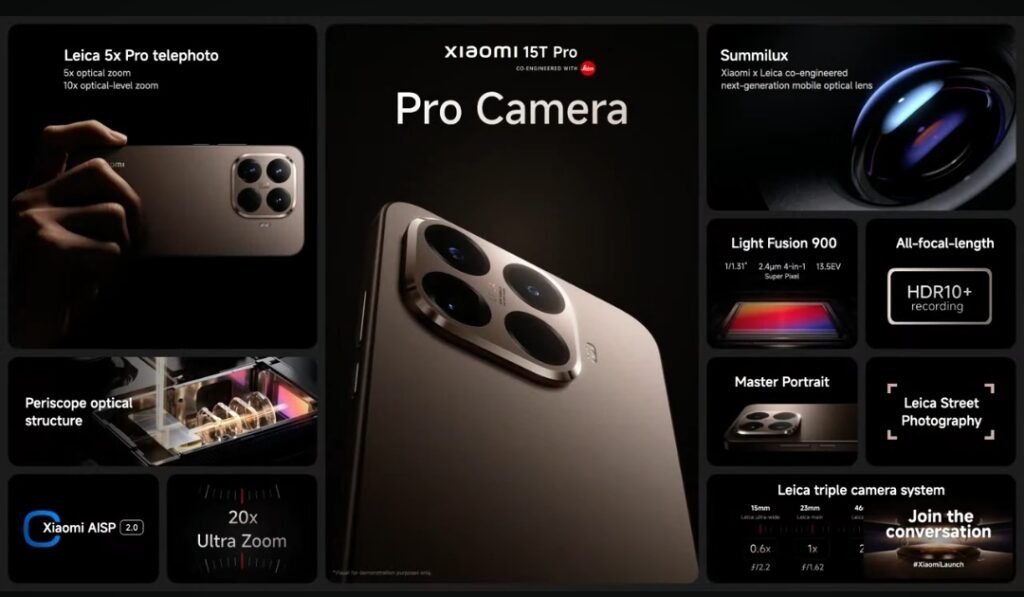
- Performance: MediaTek has produced the finest Dimensity 9400+ (3nm design, with a tri-cluster CPU incorporating a Cortex-X925 core) to power the 15T Pro. It has 12GB LPDDR5X RAM, which provides flagship-level performance. According to the Xiaomi launch event, it is as fast as most flagships. The 3D IceLoop vapor-chamber cooling that is built into the chip prevents overheating of the chip when it is used heavily.
- Cameras: The headline is the triple camera of Leica. Its main sensor is a 50MP Light Fusion 900 (f/1.62, with optical image stabilization), under a Leica Summilux lens, a 50MP periscope telephoto (115mm eq., f/3.0, with 5x optical zoom and with 50OM), and a 12MP ultra-wide (120o FoV).
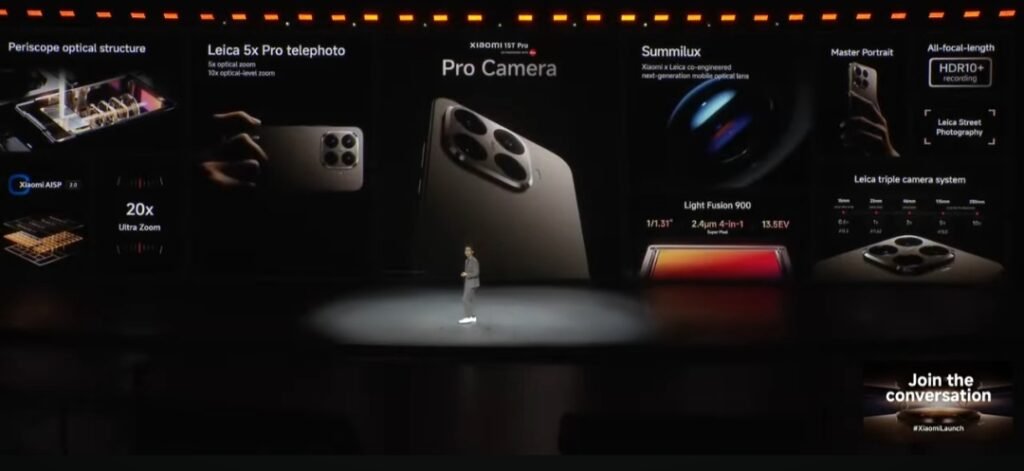
Thanks to the telephoto, the 15T Pro covers an enormous focal range (≈15–230 mm eq.) for capturing distant subjects clearly. It also supports AI-driven “UltraZoom” that boosts detail beyond 20×. Additional perks: 8K30 video and 4K120fps slow-motion on the main camera, and new camera modes such as a FastShot / Leica Street Photography mode (quick-launch shooting with preset focal lengths) and enhanced portrait modes with fancy bokeh effects. In practice reviews praise the 15T Pro’s camera setup as versatile and high-quality
- Design & Battery: The phone has a 5500 mAh battery that allows it to last throughout the day. It is fast-charged with 90W wired or 50W wireless (Xiaomi even has reverse wireless charging to charge other devices). No charger brick is included, like in the previous models (only a cable). The phone is very high-end: Android Central reports that the frosted glass-fiber back and flat aluminum frame are great to touch and should have an excellent build quality.
- Software: Xiaomi HyperOS 3 (Android 16) is included with the 15T Pro. The latest version of the OS is accompanied by a set of AI-powered features (based on Gemini models by Google) and a more intelligent assistant. (Note: initial practical reviews were unsympathetic that it was shipping on older Android 15 emanation, yet Xiaomi has updated to HyperOS 3.) It has all the standard connectivity (5G, Wi-Fi 7, Bluetooth 6, NFC, IR blaster, etc.).
Xiaomi 15T (Standard) – Value-Focused Edition
The standard 15T shares almost all of the 15T Pro’s features, but with a few cost-saving downgrades:
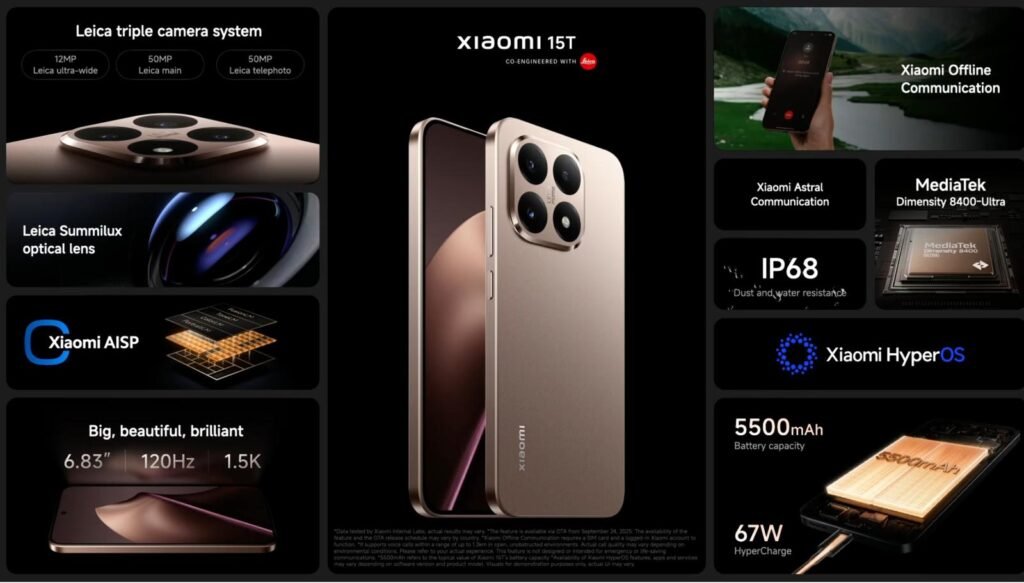
- Performance: It uses the MediaTek Dimensity 8400 Ultra chipset with 12 GB RAM. This is still a very capable 3nm chip, so everyday speed and gaming performance are strong (TechAdvisor simply calls it “solid performance”). Because the 15T is slightly smaller and uses a plastic frame, it’s lighter (194 g) than the Pro.
- Cameras: The 15T also has triple Leica cameras, but with different tuning. Its 50 MP main sensor (Light Fusion 800, f/1.7, with OIS) and 12 MP ultra-wide match the Pro. However, the telephoto is a 50 MP 46 mm-equivalent (≈2×) lens (f/1.9) without OIS. In practice, image quality is good and captures a longer reach than previous models, but it’s not quite as impressive as the Pro’s 5× zoom. Video recording tops out at 4K60. (The 15T does not support wireless charging or reverse charging.)
- Display & Battery: It has the same large 6.83 inch OLED display (this time 120Hz) and battery (5500 mAh). Xiaomi kept the IP68 rating. The battery life is fantastic; the only compromise is slower charging at 67W via wires (but then again, that is fast by general standards).
- Software & Extras: The 15T is powered by HyperOS 3 and features the new AI functionality and Gemini connectivity, just like its brother. It also receives the Offline Communication mode (the Xiaomi walkie-talkie through improved Bluetooth). It is almost the same physically except that the gold-colored model is Rose Gold rather than Mocha Gold.
Tech reviewers mention that it is basically the same phone under the hood but without some of the top-end tricks of the Pro. To illustrate, in the opinion of TechAdvisor, the 15T is a very good standalone product but is too close to its predecessor in many ways, i.e. flagship-like style with a bargain battery but not a lot of surprises.
Pricing & Availability
At launch, Xiaomi confirmed the Xiaomi 15T Series for Europe, Asia, and other select markets (no immediate US release announced). In the UK/Europe the pricing is roughly as follows:
Xiaomi 15T: Starts around €650 (about £549) for 12 GB/256 GB, and about €700 (about £599) for 12 GB/512 GB.
Xiaomi 15T Pro: Starts around €800 (£649) for 12 GB/256 GB, with €880 (£699) for 12/512 GB and €1000 (£799) for 12/1 TB.
To put this into perspective, the 15T costs around ₹65,000 to 75,000 in India (local prices), and the Pro costs around 83,000 to 99,000 (local prices). In certain areas, early adopter promotions (Mi Points, bundled accessories) are announced. These two models will be sold unlocked in its stores; sales will be in phases after the global launch.
First impressions and Reviews.
There have been positive early reviews of the hardware, along with comments of some anticipated tradeoffs to the cost.
- Design and build: Critics are unanimously in praise of the new appearance of Xiaomi. According to Android Central, the 15T series has a polished picture, and looks like a flagship. The new flat edge frame and matte back are considered a massive upgrade (the design of the 15T Pro is recommended due to all the right reasons). The gold one in particular is commented as eye-catching.
- Performance and battery: Both phones feel very fast in real-world use. Reviewers say performance is on par with true flagships. Battery life is excellent (aided by the huge 5500 mAh cell); Android Central found the 15T Pro “lasts a day without breaking a sweat”. Charging is quick, though they point out the standard 15T does now have a lower refresh rate and no wireless charging, so the Pro is clearly better-specced there.
- Cameras: The new Leica equipment in the 15T Pro is receiving positive reviews. It has a greater variety of uses than the 14T series due to its 5x telephoto and enhanced sensors. According to Android Authority, the 15T Pro has been updated to support 15-230 mm equivalent focal lengths, making it much more useful in making distant shots.
The innovations (Street Photography, advanced Portrait) are the new camera modes. On the other hand, the camera system of the standard 15T is solid yet not radically redesigned – TechAdvisor indicates that the 15T is lacking the same draw as its Pro counterpart. Concisely, critics tend to suggest the 15T Pro where camera performance is dominant.
- Software and Extras: The reviewers did mention, however, that, in contrast to many Android flagships, the Xiaomi 15T Series did not originally come with the latest version of Android. At launch the phones were on Android 15 under HyperOS and the companies had not yet confirmed a date of an Android 16 release. (Xiaomi since has released HyperOS 3, based on Android 16, and, in addition, an AI upgraded assistant, Gemini.)
The second detail most frequently criticized is that no charger comes with the box, which is a trend within the industry, but it is also mentioned by the reviewers. On the one hand, such elements as the new offline communication mode (the so-called walkie-talkie Bluetooth calls between devices) can be considered by many as a true highlight, which is not typical of most phones.

